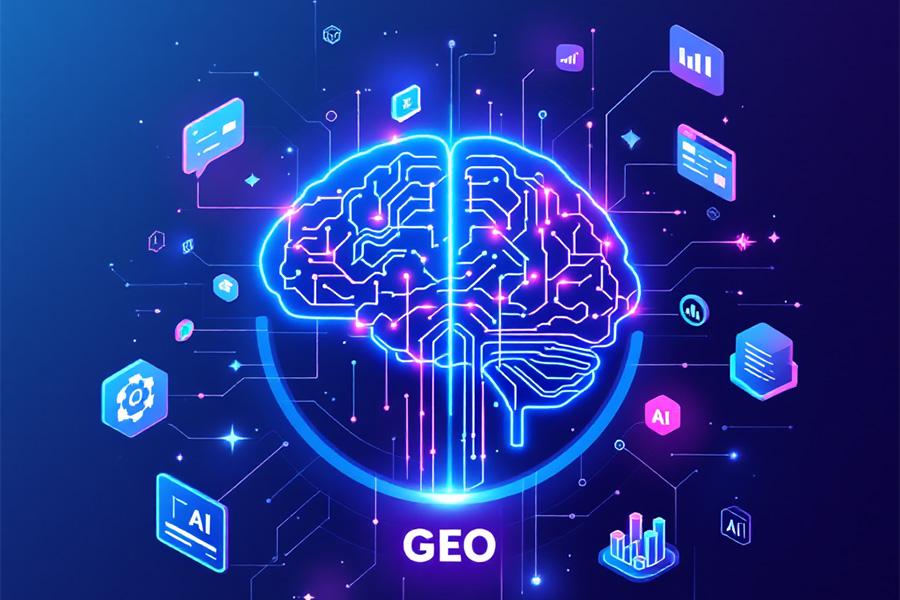Generative Engine Optimisation (GEO) has emerged as a vital strategy for improving online visibility and…
Generative Search Optimisation Vs. Search Engine Optimisation

2.
Generative Search Optimisation Vs. Search Engine Optimisation
The introduction of Generative Engine Optimisation (GEO) has created a buzz, challenging the traditional model of Search Engine Optimisation (SEO). As AI-powered systems reshape how users find and consume information, businesses must understand the similarities and differences between GEO and SEO to stay competitive and relevant.
This guide’s aim is to explore what GEO and SEO are, how they compare and why GEO is crucial in shaping the future of online visibility.
What is SEO?
SEO refers to the process of optimising websites and content to rank higher in traditional search engines like Google, Bing and Yahoo. SEO focuses on improving a website’s visibility in search engine results pages (SERPs) by targeting specific keywords, building backlinks and improving technical aspects of the site such as speed and responsiveness. Here are the key components:
![]() Keyword Optimisation: Putting relevant keywords into content to align with searches.
Keyword Optimisation: Putting relevant keywords into content to align with searches.
![]() Backlinks: Building a network of high-quality links to increase domain authority.
Backlinks: Building a network of high-quality links to increase domain authority.
![]() Meta Tags and Descriptions: Including titles, descriptions and headers to improve CTR.
Meta Tags and Descriptions: Including titles, descriptions and headers to improve CTR.
![]() Technical SEO: Ensuring fast load times, mobile-friendliness and proper indexing.
Technical SEO: Ensuring fast load times, mobile-friendliness and proper indexing.
![]() Content Creation: Producing high-quality, relevant content that matches search intent.
Content Creation: Producing high-quality, relevant content that matches search intent.
What is GEO?
GEO is a relatively new approach to optimisation, focusing on AI-driven search engines and generative systems. With the rise of tools like ChatGPT, Google’s Bard and Bing AI, content is now consumed through conversational AI models that summarise, interpret and generate responses based on user queries. GEO revolves around creating content that is AI-friendly, easy for AI systems to interpret and aligned with user intent. Here are the key components:
![]() AI-Friendly Content: Structuring content to be easily understood by AI systems.
AI-Friendly Content: Structuring content to be easily understood by AI systems.
![]() User Intent Alignment: Answering user queries in concise and direct ways.
User Intent Alignment: Answering user queries in concise and direct ways.
![]() Structured Data: Use schema mark-up to help AI understand context within the content.
Structured Data: Use schema mark-up to help AI understand context within the content.
![]() Natural Language: Use a tone that matches natural phrasing of questions.
Natural Language: Use a tone that matches natural phrasing of questions.
![]() Multimodal Content: images, videos and other media that systems can reference.
Multimodal Content: images, videos and other media that systems can reference.
How GEO Complements SEO
While both differ in focus, they are not mutually exclusive. In fact, GEO builds upon traditional SEO principles to adapt to the rise of AI-powered search systems. Here’s how they complement each other:
![]() Content Relevance: Both prioritise quality content. While SEO targets SERP rankings, GEO ensures that the content is accessible and relevant for AI systems.
Content Relevance: Both prioritise quality content. While SEO targets SERP rankings, GEO ensures that the content is accessible and relevant for AI systems.
![]() Technical Optimisation: Structured data, fast-loading websites and mobile responsiveness are vital for both.
Technical Optimisation: Structured data, fast-loading websites and mobile responsiveness are vital for both.
![]() User Experience: Both approaches aim to improve user satisfaction, whether through clickable links (SEO) or AI-delivered answers (GEO).
User Experience: Both approaches aim to improve user satisfaction, whether through clickable links (SEO) or AI-delivered answers (GEO).
Why GEO is the Future of Search Optimisation
As AI technologies continue to evolve, GEO is becoming increasingly important. Here’s why:
![]() Rise of AI Assistants: With tools like ChatGPT, Siri, Alexa and Google Assistant gaining popularity, users are now relying on conversational AI rather than traditional search engines.
Rise of AI Assistants: With tools like ChatGPT, Siri, Alexa and Google Assistant gaining popularity, users are now relying on conversational AI rather than traditional search engines.
![]() Shift to Direct Answers: Generative AI systems provide answers directly, reducing the need for users to click on multiple links. It ensures your content is included in these answers.
Shift to Direct Answers: Generative AI systems provide answers directly, reducing the need for users to click on multiple links. It ensures your content is included in these answers.
![]() Enhanced Personalisation: AI-powered systems tailor responses to individual user needs, making GEO vital to create content that resonates with diverse audiences.
Enhanced Personalisation: AI-powered systems tailor responses to individual user needs, making GEO vital to create content that resonates with diverse audiences.
Tips for Balancing GEO and SEO Strategies
![]() Understand AI Trends: Stay informed about how AI-powered search engines function and what factors influence rankings.
Understand AI Trends: Stay informed about how AI-powered search engines function and what factors influence rankings.
![]() Use Structured Data: Implement schema mark-up to improve visibility in both traditional SERPs and AI-generated summaries.
Use Structured Data: Implement schema mark-up to improve visibility in both traditional SERPs and AI-generated summaries.
![]() Focus on User Intent: Create content that answers questions clearly and concisely.
Focus on User Intent: Create content that answers questions clearly and concisely.
![]() Incorporate Long-Tail Keywords: These are important for both traditional SEO and natural language queries used in AI-powered search.
Incorporate Long-Tail Keywords: These are important for both traditional SEO and natural language queries used in AI-powered search.
![]() Expand Content Formats: Include videos, infographics and other media that AI systems can analyse and summarise.
Expand Content Formats: Include videos, infographics and other media that AI systems can analyse and summarise.
While SEO remains a cornerstone of digital marketing, GEO represents the future of search optimisation in an AI-driven world. By combining the principles of SEO with the emerging practices of GEO, businesses can position themselves for success in both traditional search engines and AI-powered systems.
As AI technologies continue to evolve, learning to adapt to GEO is no longer optional—it’s essential. The key is to strike a balance between the tried-and-true methods of SEO and the innovative practices of GEO to ensure your content is visible, engaging and relevant in every context.
If you’d like further insights or help implementing GEO and SEO strategies, contact us today!

